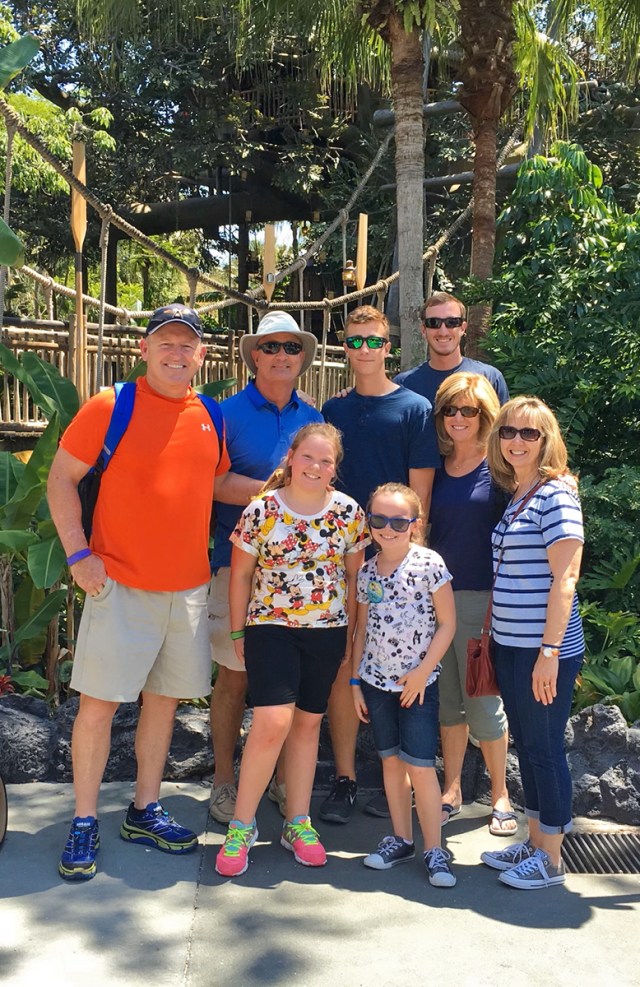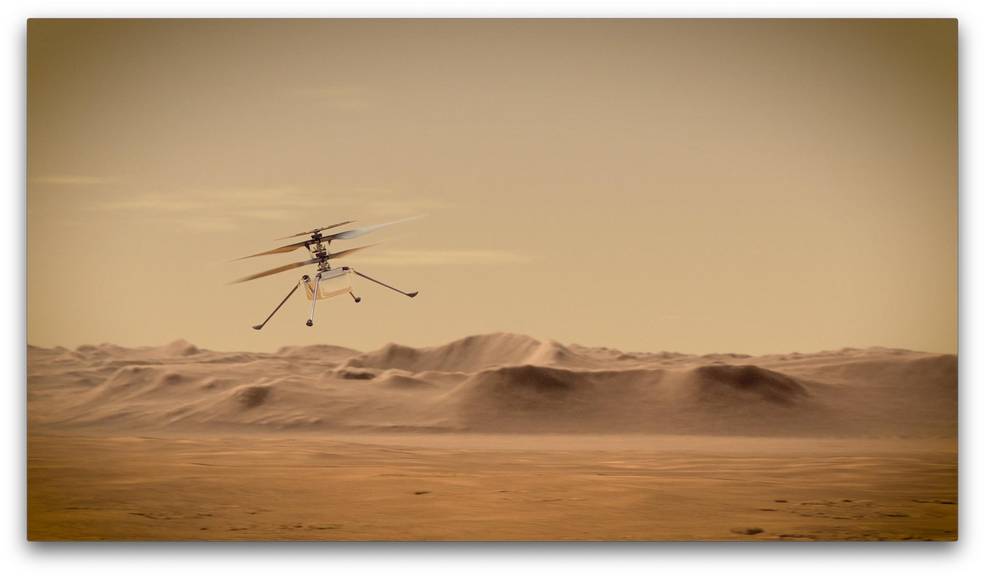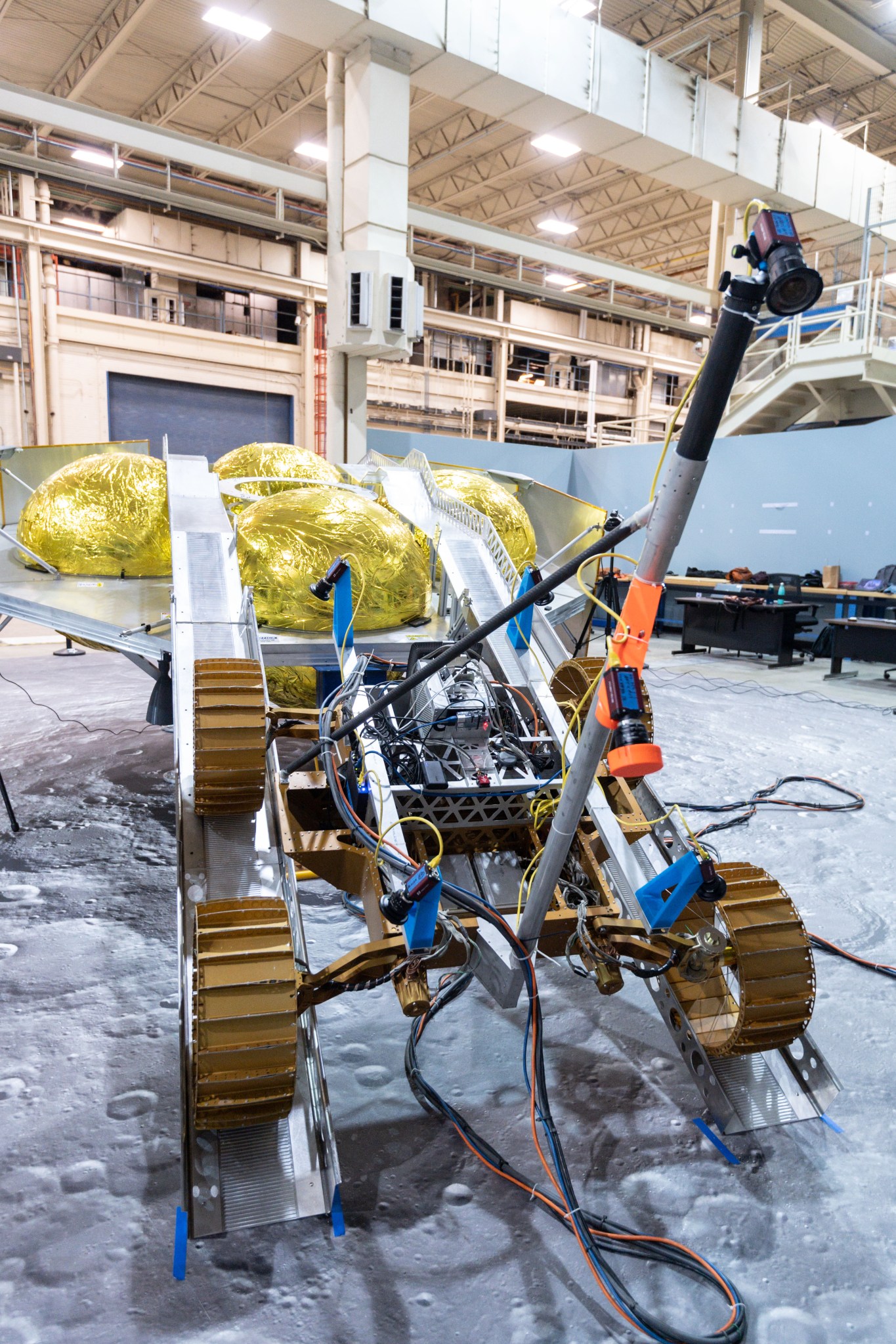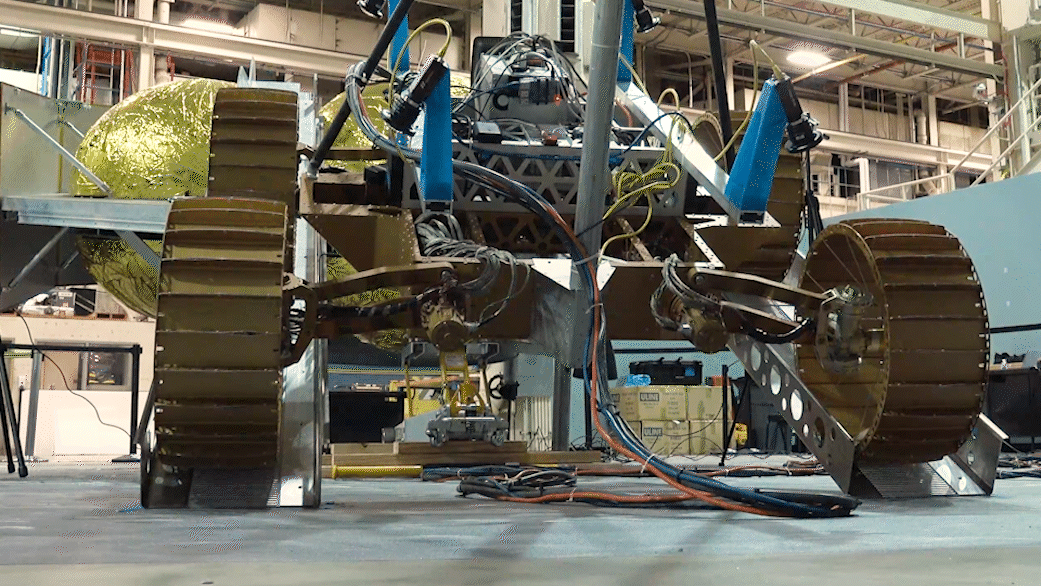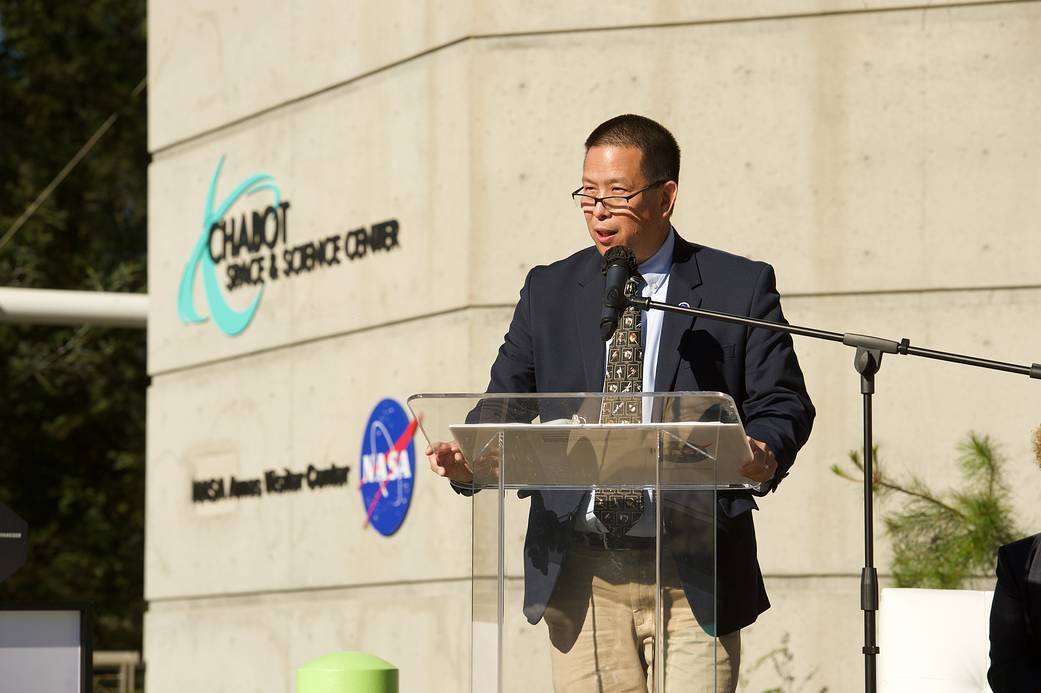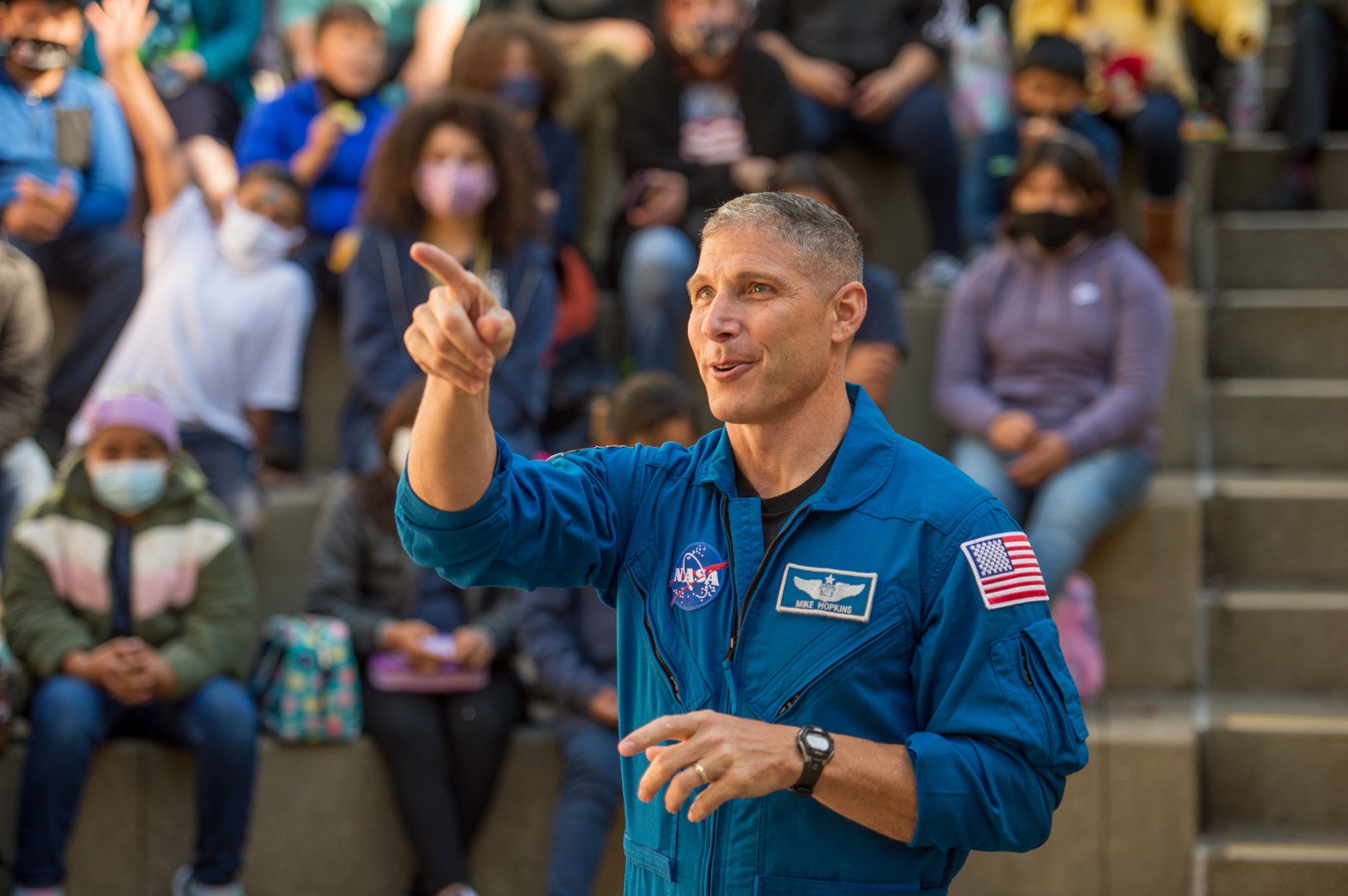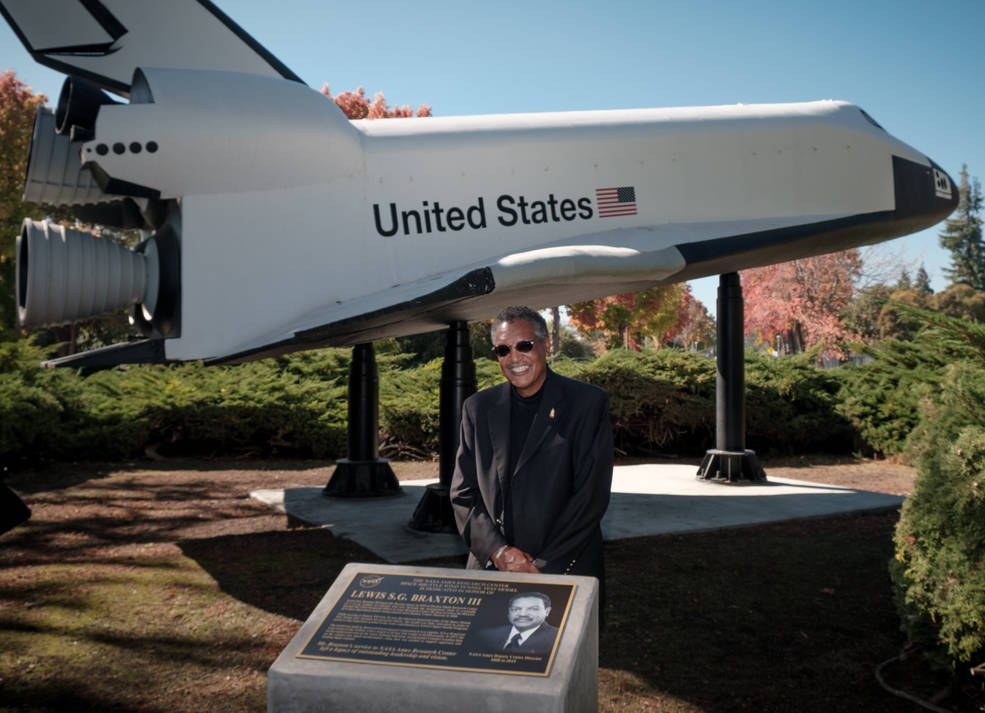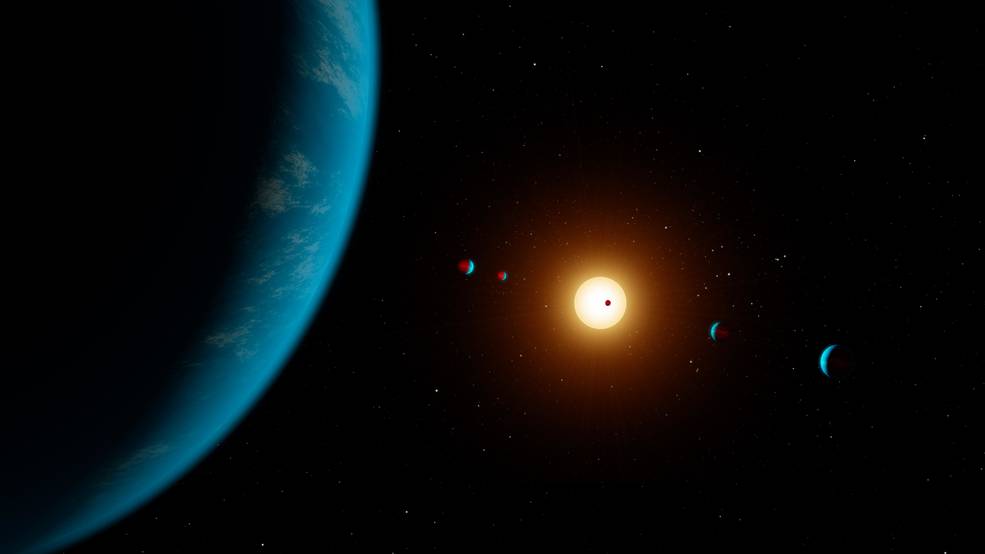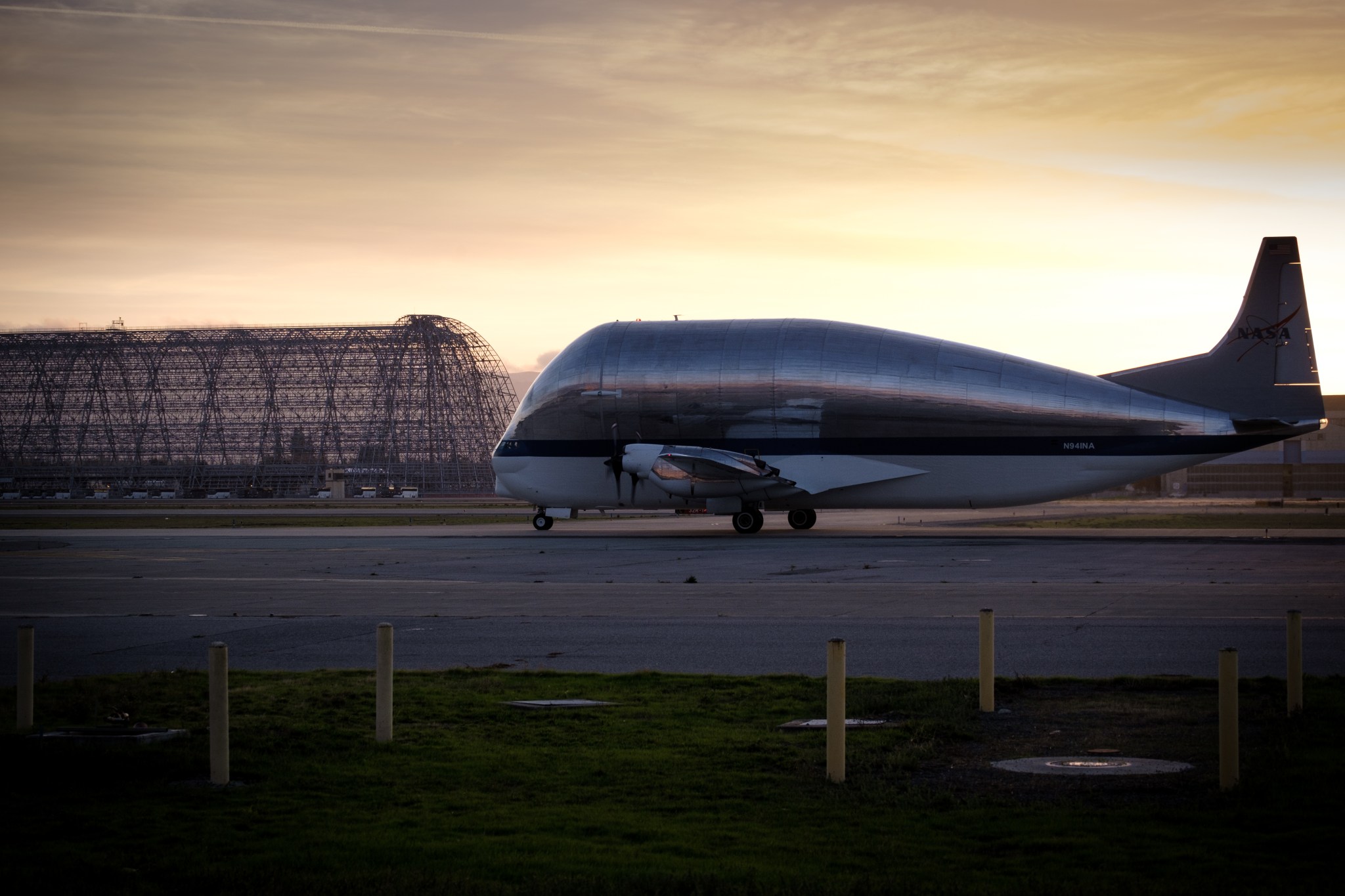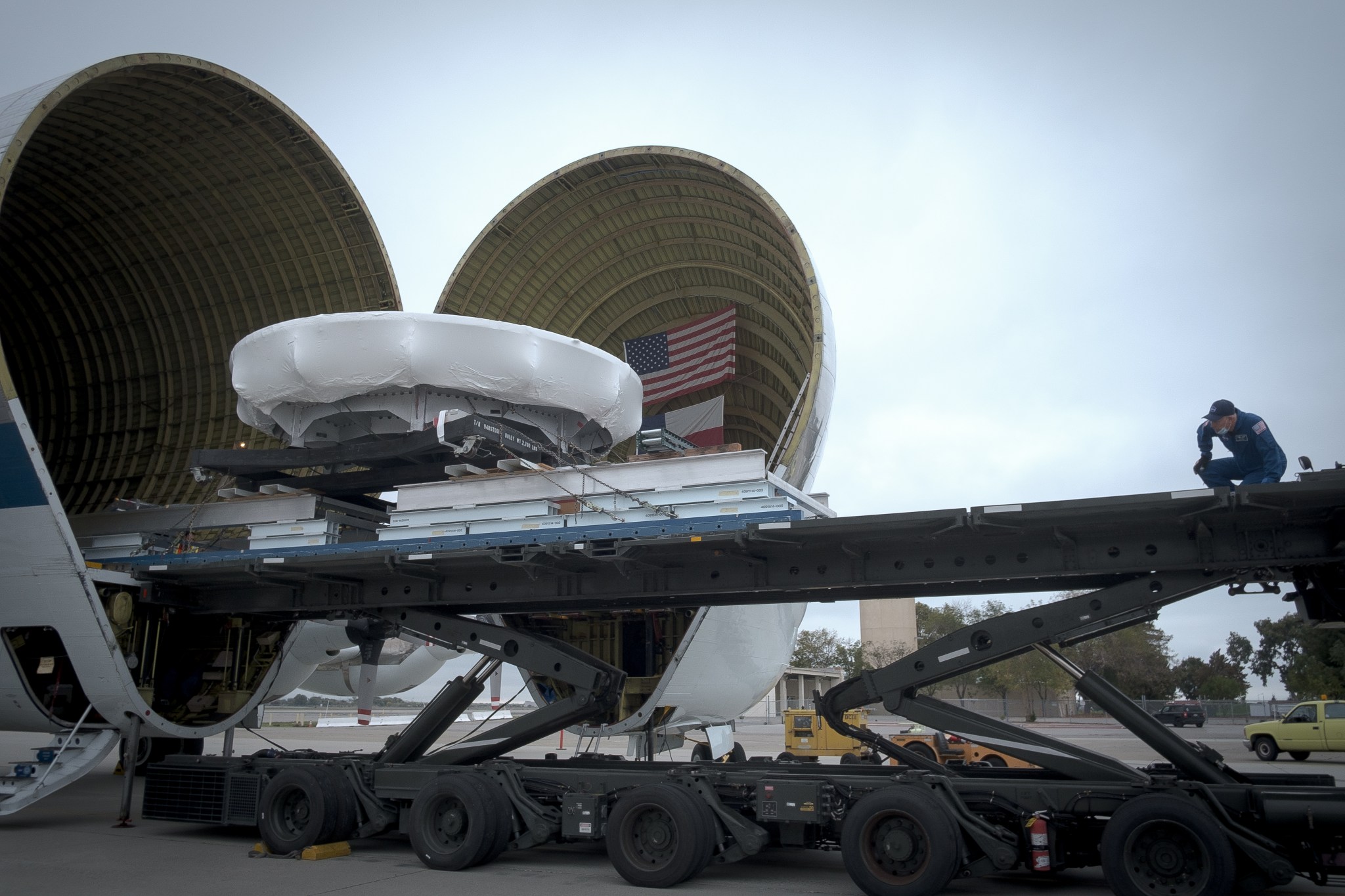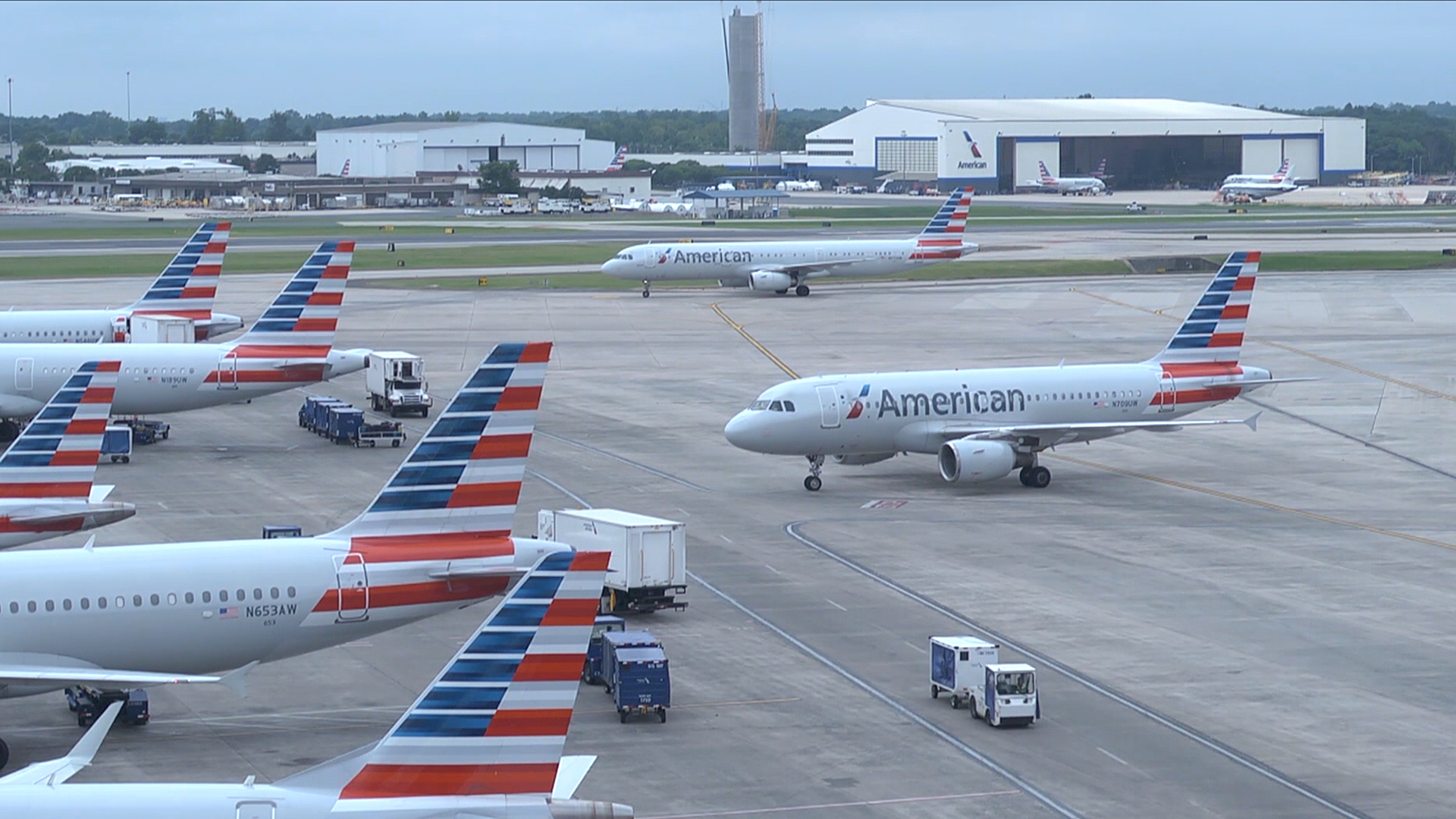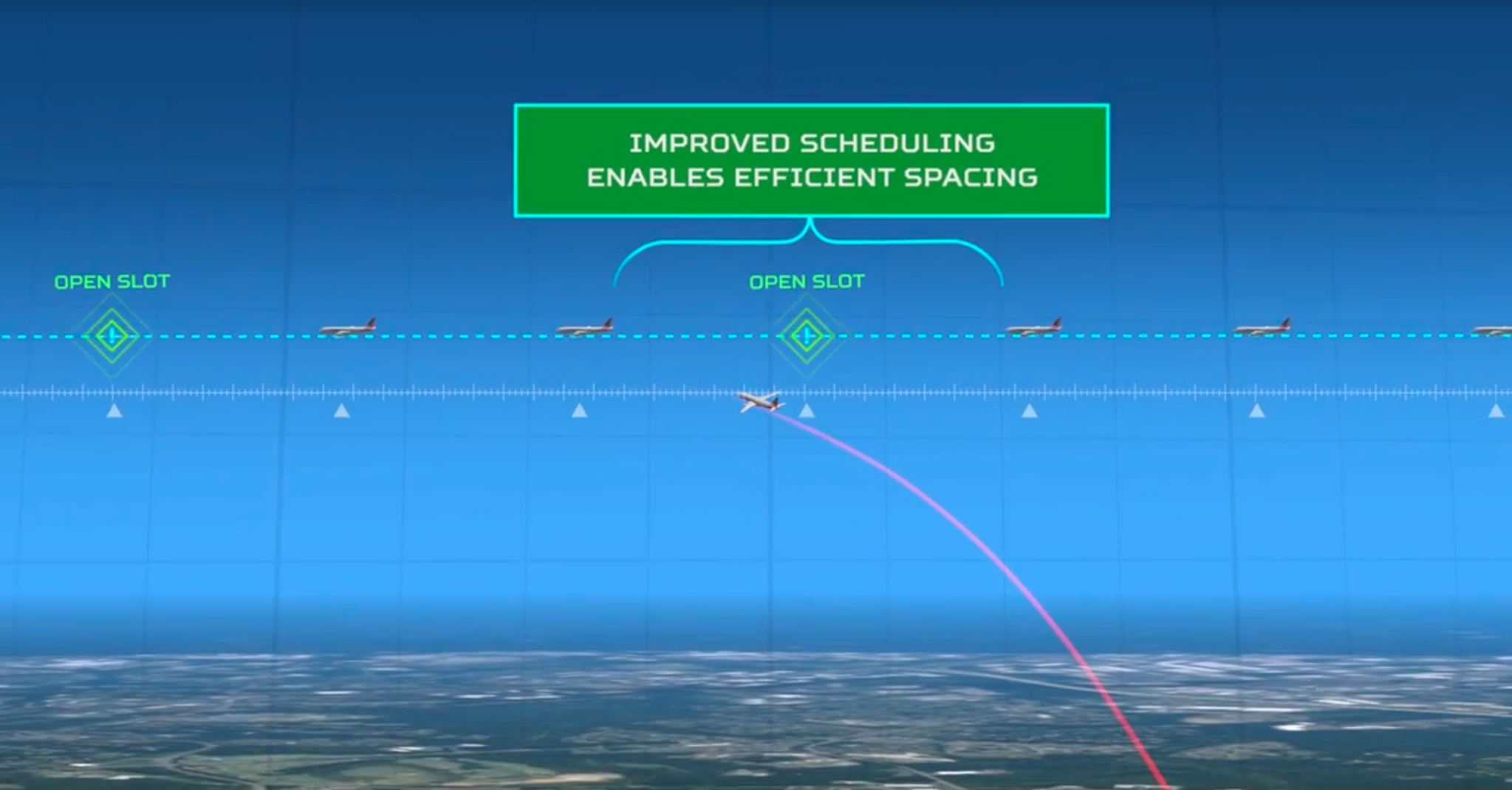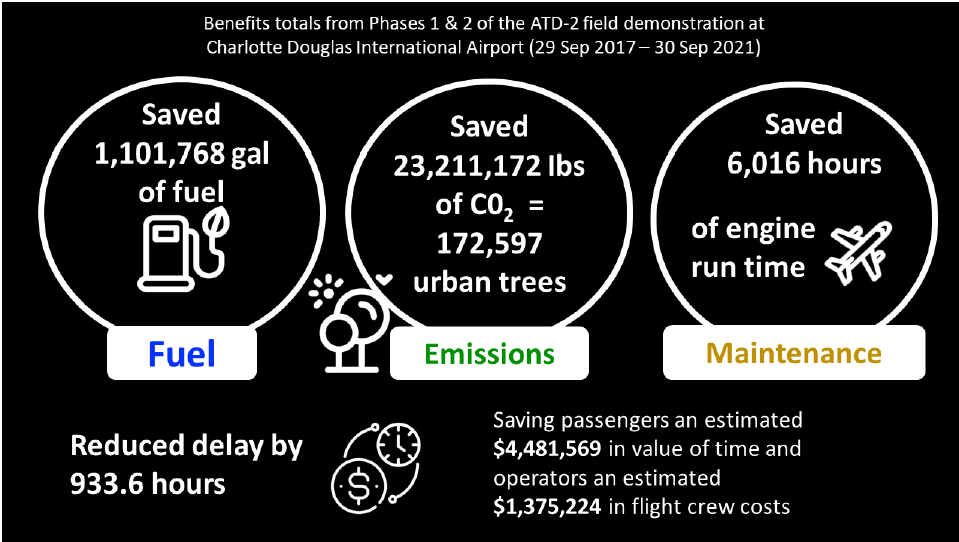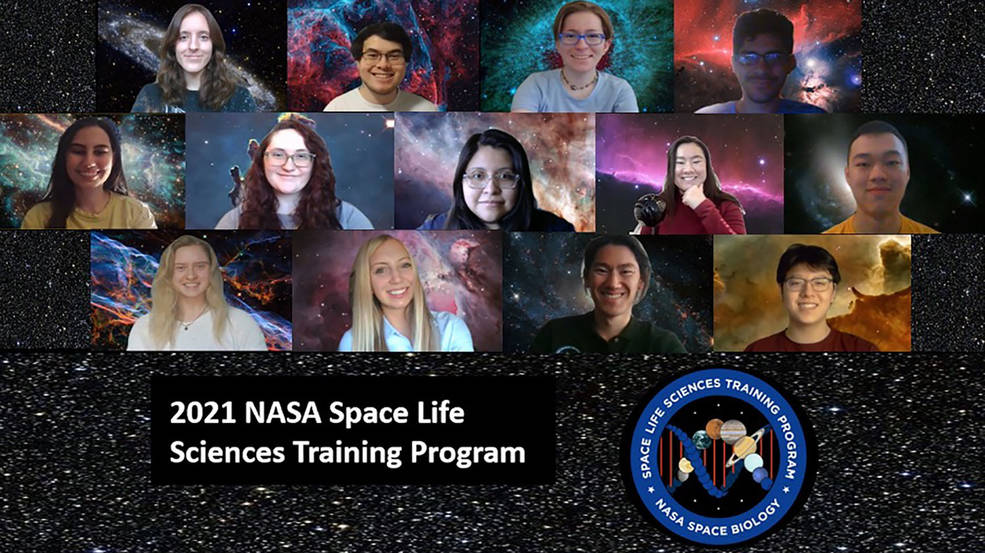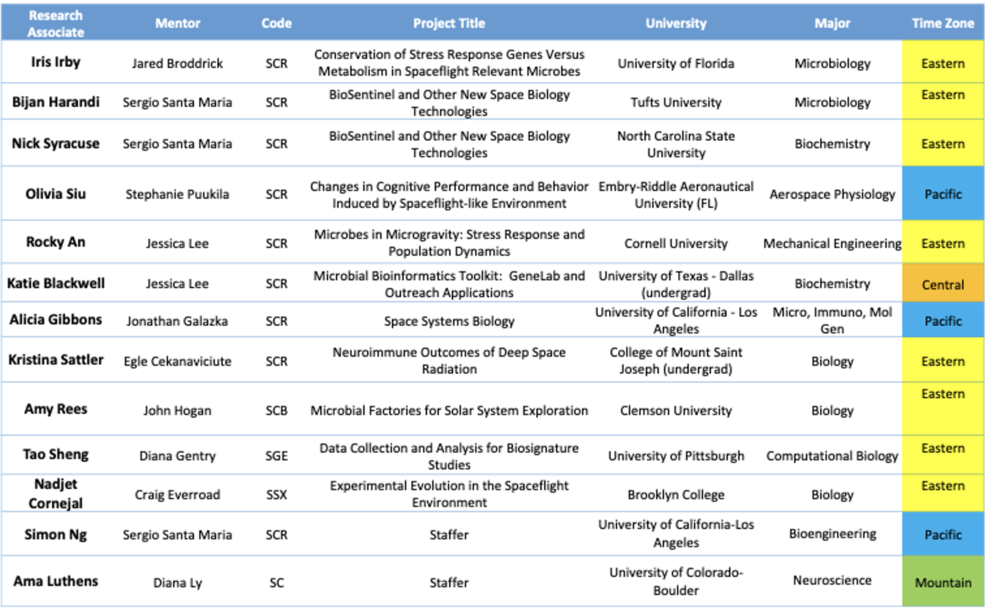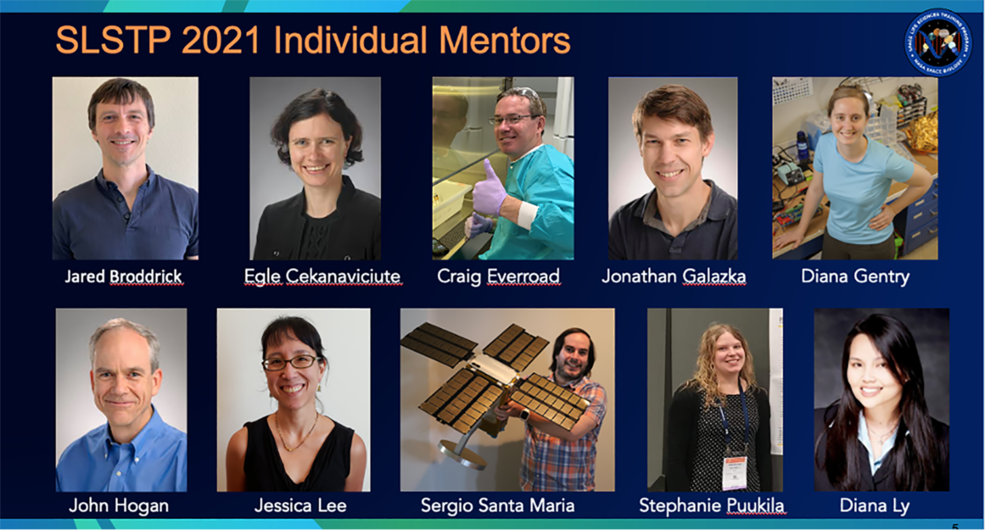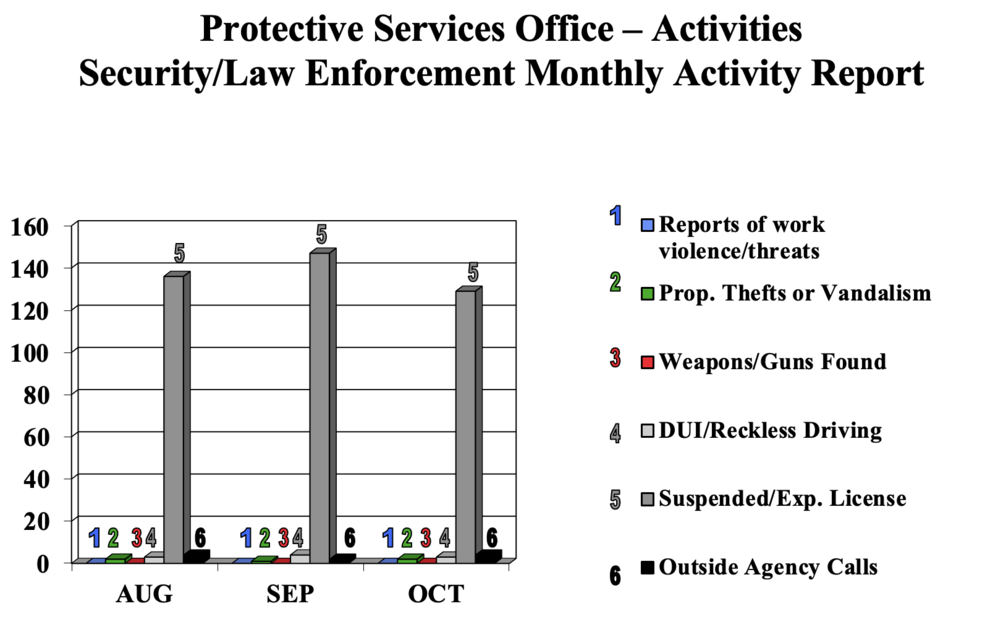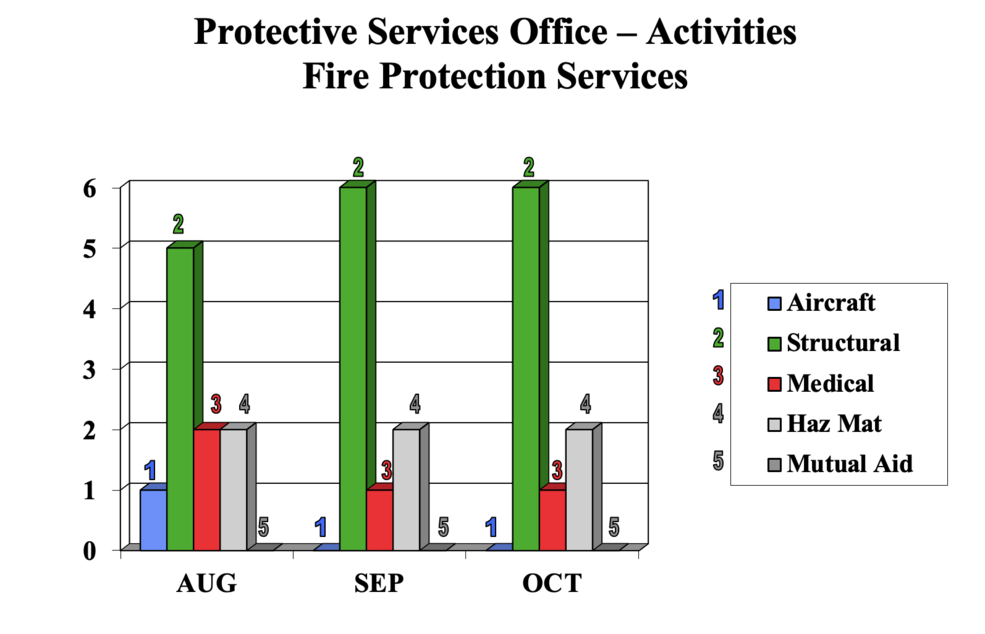November 2021 issue of Ames' newsletter, the Astrogram
Ingenuity Mars Helicopter Team Honored With Achievement Award
NASA’s Ingenuity Mars Helicopter team was recently honored by a group that really knows their helicopters. The team was recognized with the 2021 Achievement Award of the American Helicopter Museum and Education Center, in West Chester, Pennsylvania.
Ames’ own Carlos Malpica represented the NASA Aeronautics arm of the team at the museum’s award gala on Saturday, Oct. 16.
Ingenuity is a technology experiment and the first aircraft to attempt controlled flight on another planet. It arrived on Mars on Feb. 18, 2021, attached to the belly of NASA’s Mars 2020 Perseverance rover. On Apr. 19 it succeeded in its historic first flight.
“History is made every day, and the…Ingenuity team certainly made and continues to make history as Ingenuity explores the Red Planet,” wrote Bob Beggs, co-founder and trustee of the museum.
Congratulations to the whole team and to Ames’ team members who contributed their aeronautical expertise!
VIPER Practices All-Wheel Drive to the Moon
by Rachel Hoover
How does an Artemis rover prepare to drive off its lander and roll onto the rocky surface of the Moon? With a test drive on Earth, of course.
NASA’s Volatiles Investigating Polar Exploration Rover, or VIPER, is the agency’s first lunar mobile robot. This marks the second round of VIPER rover egress testing at Johnson Space Center in Houston, building on lessons learned from the first test.
Egress refers to the process of the rover exiting the lander after being carried from Earth to the Moon and driving onto the lunar surface itself. This is similar to a car being driven off a cross-country car hauler, except after an interplanetary journey.
The egress test used the latest hardware and software in development for the VIPER mission, as well as updated ramps on the Griffin lander with new aluminum surface features. A prototype of the rover was driven down the ramps using the latest versions of the driving tools and software.
The testing was conducted with the lander positioned at tilted angles, simulating the lander touching down on a slope. This allowed the VIPER team to test the most extreme exit scenarios off the lander.
The VIPER mission is managed out of NASA’s Ames Research Center in California’s Silicon Valley, and is scheduled to be delivered to the Moon in late 2023 by Astrobotic’s Griffin lander as part of the Commercial Lunar Payload Services initiative. Construction of the rover will begin in late 2022 at NASA’s Johnson Space Center in Houston, while the rover flight software and navigation system design will take place at Ames. Astrobotic will receive the complete rover with its scientific instruments in mid-2023 in preparation for launch later that year.
The NASA Experience Opens at Chabot Space and Science Center in Oakland, California
by Frank Tavares
Elected officials and community members from across the Bay Area joined NASA leadership today for the opening of the NASA Experience exhibit at Chabot Space and Science Center in Oakland, California. This exhibit serves as a new visitor center for NASA’s Ames Research Center in California’s Silicon Valley, and provides a dynamic and interactive space for the public to learn more about local contributions to space exploration across the years.
“This is an incredible opportunity for NASA to share artifacts never before seen by the public,” said Mike Kincaid, Associated Administrator for the Office of STEM Engagement at NASA Headquarters. “This new visitor center for Ames is bringing NASA out into local communities and putting the stories of NASA’s people front and center.”
From models of spacecraft and genuine spacesuits from as early as the Mercury and Gemini missions to artifacts related to NASA’s upcoming Artemis missions, the NASA Experience gives visitors access to over 80 years of Ames history a look into current and future projects. Ames’ expertise in wind tunnel testing, rover design and testing, space robotics, supercomputing, and more is on display.
“We are so excited to share with our community the incredible stories and the people behind NASA Ames,” said executive director Adam Tobin of Chabot. “This opening launches our larger shared vision for re-imagining STEM education. This is just the beginning.”
The exhibit also highlights the people of Ames, with interactive ways of learning about the stories that brought scientists, engineers, artists, and more from across the world to work for NASA in Silicon Valley. Learn more about the NASA Experience and plan your own visit.
Former Ames Deputy Directory Lewis S.G. Braxton III Honored in Dedication Ceremony
On Friday, Oct. 29 at the NASA Research Park Parade Ground, the Space Shuttle Wind Tunnel Test Model was dedicated in honor of Lewis S.G. Braxton III, former Ames deputy director. Due to COVID-19 restrictions, attendance at the event was limited to only family and close friends. It was a privilege for me to preside over this event, celebrating Lew’s service to our center, his legacy of exemplary leadership, and the innovative vision he left that continues to influence us today. We hope in the future to hold a celebration of the dedication with the Ames family. Congratulations, to our esteemed colleague, my friend, Lew Braxton.–Dr. Eugene Tu, Center Director
The wording on the plaque is as follows:
“The NASA Ames Research Center Space Shuttle Wind Tunnel Test Model is dedicated in honor of Lewis S.G. Braxton III.
Lewis S.G. Braxton III began his 40-year career in 1975 at Dryden Flight Research Center as a co-op student accountant and rose through the management chain to eventually become the Chief Financial Officer at Ames Research Center. He then served as the Director of Center Operations before being named Ames Deputy Center Director in 2008.
While serving as deputy director, he saw the inherent historical value of the Space Shuttle Test Model and, through his personal efforts, the model was fully renovated in order to preserve this important symbol of the Ames contribution to NASA’s Space Shuttle Program.
The model was built by Rockwell International Corporation in Los Angeles. It is a 36 percent scale model of the Orbiter with a length of 44 feet and weight of 45,000 pounds. In 1977, the model underwent tests in the Ames National Full-Scale Aeronautics Complex to gather data on the vehicle’s low speed aerodynamics—data that was needed to support approach and landing flight regimes.
Mr. Braxton’s service to NASA Ames Research Center left a legacy of outstanding leadership and vision.”
New Deep Learning Method Adds 303 Planets to Kepler
by Rachel Hoover
Scientists recently added a whopping 301 newly validated exoplanets to the total exoplanet tally. The throng of planets is the latest to join the 4,569 already validated planets orbiting a multitude of distant stars. How did scientists discover such a huge number of planets, seemingly all at once? The answer lies with a new deep neural network called ExoMiner.
Deep neural networks are machine learning methods that automatically learn a task when provided with enough data. ExoMiner is a new deep neural network that leverages NASA’s Pleiades supercomputer, and can distinguish real exoplanets from different types of imposters, or “false positives.” Its design is inspired by various tests and properties human experts use to confirm new exoplanets. And it learns by using past confirmed exoplanets and false positive cases.
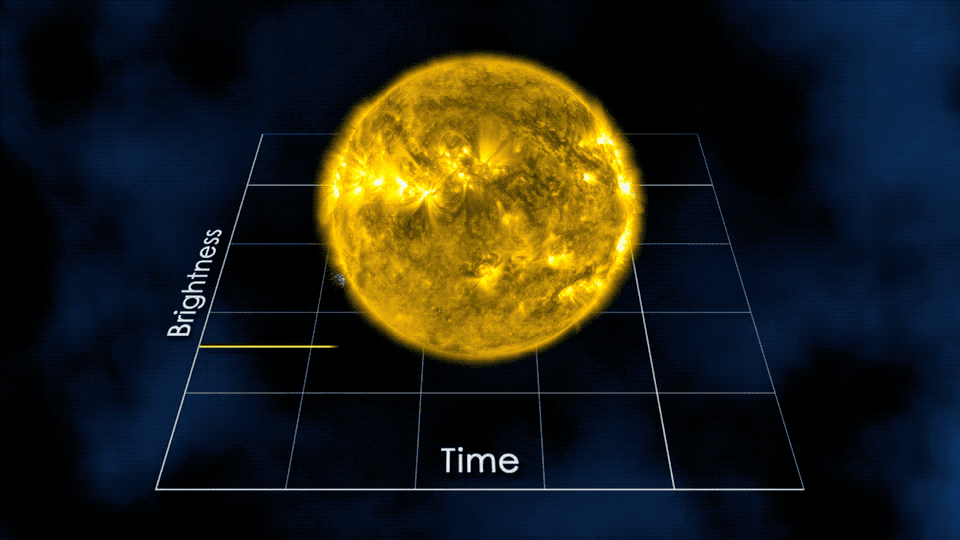
ExoMiner supplements people who are pros at combing through data and deciphering what is and isn’t a planet. Specifically, data gathered by NASA’s Kepler spacecraft and K2, its follow-on mission. For missions like Kepler, with thousands of stars in its field of view, each holding the possibility to host multiple potential exoplanets, it’s a hugely time-consuming task to pore over massive datasets. ExoMiner solves this dilemma.
“Unlike other exoplanet-detecting machine learning programs, ExoMiner isn’t a black box – there is no mystery as to why it decides something is a planet or not,” said Jon Jenkins, exoplanet scientist at NASA’s Ames Research Center in California’s Silicon Valley. “We can easily explain which features in the data lead ExoMiner to reject or confirm a planet.”
What is the difference between a confirmed and validated exoplanet? A planet is “confirmed,” when different observation techniques reveal features that can only be explained by a planet. A planet is “validated” using statistics – meaning how likely or unlikely it is to be a planet based on the data.
In a paper accepted for publication in The Astrophysical Journal, the team at Ames shows how ExoMiner discovered the 301 planets using data from the remaining set of possible planets – or candidates – in the Kepler Archive. All 301 machine-validated planets were originally detected by the Kepler Science Operations Center pipeline and promoted to planet candidate status by the Kepler Science Office. But until ExoMiner, no one was able to validate them as planets.
The paper also demonstrates how ExoMiner is more precise and consistent in ruling out false positives and better able to reveal the genuine signatures of planets orbiting their parent stars – all while giving scientists the ability to see in detail what led ExoMiner to its conclusion.
“When ExoMiner says something is a planet, you can be sure it’s a planet,” added Hamed Valizadegan, ExoMiner project lead and machine learning manager with the Universities Space Research Association at Ames. “ExoMiner is highly accurate and in some ways more reliable than both existing machine classifiers and the human experts it’s meant to emulate because of the biases that come with human labeling.”
None of the newly confirmed planets are believed to be Earth-like or in the habitable zone of their parent stars. But they do share similar characteristics to the overall population of confirmed exoplanets in our galactic neighborhood.
“These 301 discoveries help us better understand planets and solar systems beyond our own, and what makes ours so unique,” said Jenkins.
As the search for more exoplanets continues – with missions using transit photometry such as NASA’s Transiting Exoplanet Survey Satellite, or TESS, and the European Space Agency’s upcoming PLAnetary Transits and Oscillations of stars, or PLATO, mission – ExoMiner will have more opportunities to prove it’s up to the task.
“Now that we’ve trained ExoMiner using Kepler data, with a little fine-tuning, we can transfer that learning to other missions, including TESS, which we’re currently working on,” said Valizadegan. “There’s room to grow.”
NASA’s Ames Research Center in California’s Silicon Valley managed the Kepler and K2 missions for NASA’s Science Mission Directorate. NASA’s Jet Propulsion Laboratory in Pasadena, California, managed Kepler mission development. Ball Aerospace & Technologies Corporation in Boulder, Colorado, operated the flight system with support from the Laboratory for Atmospheric and Space Physics at the University of Colorado in Boulder.
NASA’s Super Guppy Arrives in California with Future Artemis Heat Shield
by Frank Tavares
Crews transported the heat shield skin for a future mission of NASA’s Orion spacecraft — via the agency’s Super Guppy oversize cargo transport aircraft — to Moffett Federal Airfield on Nov. 9. The heat shield skin for the Artemis IV mission, the third crewed mission to the Moon, is now at Moffett Federal Airfield near NASA’s Ames Research Center in California’s Silicon Valley, for the next phase of production.
Orion’s heat shield protects the spacecraft and the astronauts inside the capsule from the intense heat generated while re-entering Earth’s atmosphere. When the spacecraft re-enters at roughly 25,000 miles per hour, the heat shield will experience extreme temperatures at about 5,000 degrees Fahrenheit, or about half as hot as the sun. The heat shield has an underlying titanium skeleton covered by a carbon fiber skin. More than 180 unique blocks are bonded to the heat shield’s skin and will slowly burn away as the spacecraft travels through Earth’s atmosphere during re-entry.
The recently delivered heat shield skin will undergo heat- and pressure-treatment at Lockheed Martin’s facility in Sunnyvale, California. The heat shield skin is made up of many layers of carbon fabric that are activated by a resin. Once cured, the resin will first soften, then harden to consolidate the skin. The heat- and pressure-treatment will give the skin the necessary mechanical strength properties it needs for Orion’s thermal protection system.
Unlike other aircraft, the Super Guppy aircraft has a specially designed hinged nose that opens to an angle of 110 degrees so that cargo can be loaded and unloaded from its belly. The aircraft’s unique shape also allows it to carry bulky or heavy hardware that would not otherwise fit on traditional aircraft. At 16.5 feet in diameter, the Orion heat shield and its corresponding skin is the largest heat shield base ever developed for human spaceflight missions.
Ames oversees the development, analysis, and arc jet testing of the entry systems and spacecraft for NASA’s Artemis lunar missions. Through Artemis, NASA will land the first woman and first person of color on the lunar surface, conduct extensive operations on and around the Moon, and prepare for the first human mission to Mars.
NASA Supercomputers Predict How Vibrations Vary with Altitude for Orion Abort Scenarios
by Gianine Figliozzi
As part of the Artemis missions, NASA’s Orion spacecraft will carry the first woman and first person of color to the Moon and return them safely back to Earth. Orion will sit atop the most powerful rocket in the world, NASA’s Space Launch System, to launch humans to deep space. An integral part of ensuring astronaut safety is Orion’s launch abort system that can pull the crew module away from the rocket in a split-second if an emergency arises during launch.
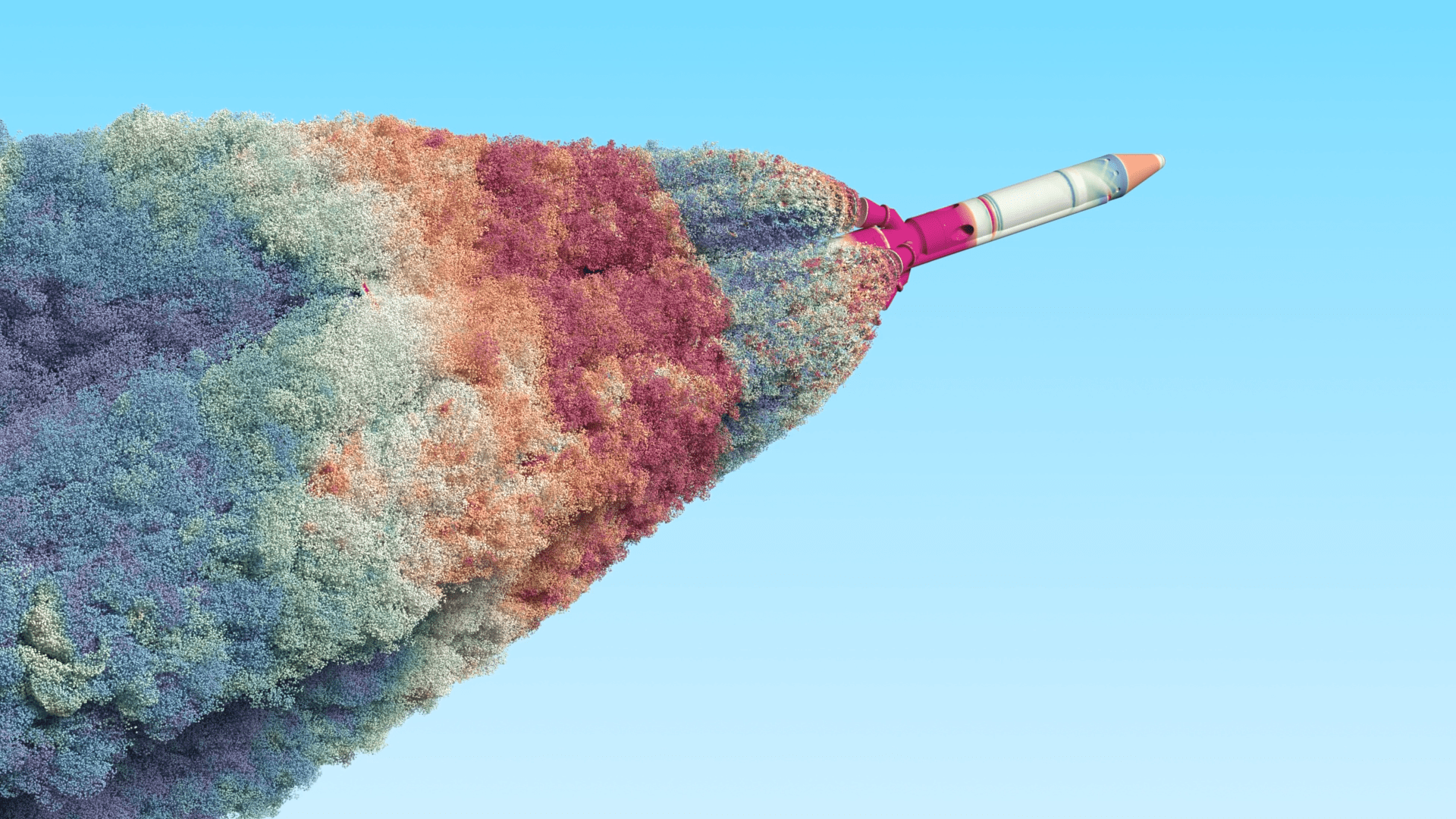
Orion’s launch abort system sits over the Orion capsule, and the abort function is powered by a solid rocket motor on the abort tower. The abort maneuver resembles the action of an “eject button” for a crew capsule. The abort motor produces hot, turbulent, high-speed exhaust plumes that flow along the sides of Orion. These plumes create intense pressure waves that can cause vibrations in the combined structure of the launch abort system with the Orion spacecraft as it is pulled away from the rocket. NASA researchers analyze these vibrations to ensure the system doesn’t shake itself apart in flight.
An abort could be triggered at any stage during launch or ascent to space. Altitude, speed, direction, and orientation of the rocket constantly change during ascent. These factors affect the strength and extent of the acoustic vibrations the motor’s plumes generate during an abort. The abort system will need to perform under extremely different conditions.
Researchers at NASA’s Ames Research Center in California’s Silicon Valley are using their cutting-edge computational fluid dynamics software called LAVA (Launch, Ascent, and Vehicle Aerodynamics) to predict and better understand how different abort scenarios – from the launchpad to the edge of space – will affect vibration levels. The Ames team performed three simulations of the launch abort vehicle that flew on NASA’s Ascent Abort-2 test. In each simulation, abort happened under circumstances different from NASA’s Ascent Abort-2 flight test. In one scenario – early in the flight – abort occurred at low altitude while traveling close to the speed of sound where the rocket’s orientation is misaligned with its direction of flight. In another simulation, the abort triggered later in the flight while the rocket is still at low altitude but traveling faster than the speed of sound. A third scenario studied the last opportunity to abort before reaching space where the rocket was traveling though thin air at very high altitude at nearly five times the speed of sound.
These simulations were performed on NASA’s Aitken and Electra supercomputers. These computational fluid dynamics predictions help reduce uncertainty for abort scenarios that are difficult or too expensive to test, like the high altitude near-hypersonic abort, further helping to reduce risk and ensure the safety of astronauts. The technology is helping advance NASA’s missions by making it possible to run tests in a supercomputer at lower cost and with faster turnarounds before flight, ultimately making NASA exploration systems safer.
NASA showcased 39 of the agency’s exciting computational achievements at SC21, the international supercomputing conference, Nov. 14-19, 2021, in St. Louis, Missouri. For more technical information, visit: www.nas.nasa.gov/SC21.
NASA Technology Helps Air Travelers Get Smoothly from Gate to Sky
What is the Airspace Technology Demonstration 2?
by Abigail Tabor
After more than a year of pandemic-related travel restrictions, many people excitedly boarded planes to take them on long-awaited vacations. Plenty then sighed and settled in for a long wait: their takeoff was delayed, and they’d be sitting on the tarmac a while. Commercial air travel relies on intricate operations at the airport, and, with so many variables in play, inefficiencies can easily crop up.
That’s something NASA’s Airspace Technology Demonstration 2, or ATD-2, project aimed to change. One of a trio of projects tackling challenges faced in air traffic management, ATD-2 developed technologies that predict airport traffic conditions and determine the best time for departing flights to push back from the gate.
This both reduces delays and shifts wait time to the gate, instead of on the taxiway with engines running. The ultimate goal is to get travelers from gate to runway to the sky with minimal delay. And the benefits – for schedules, passengers, airlines, and the environment – are already adding up.
Optimizing the Flow of Flights
Most of us take for granted everything that goes into running a functional airport. But a great deal of information on arrivals, departures, surface traffic, delays, sudden changes in weather, and more must be tracked, communicated, and adjusted for by different groups of people.
The current system handles all this using a simple physical queue: when a plane is ready for departure, it gets in line and waits to use the runway. But, when unexpected problems arise, this queue can quickly back up, affecting both departures and arrivals. To protect against those consequences, air traffic managers may add more buffer time to flight schedules – an additional inefficiency.
By making the movements of aircraft from surface to sky more predictable, NASA researchers aimed to help reduce that buffer, and optimize the flow of flights through airports. The ATD-2 tools help get planes queued up in the best way to take their designated spot in the air traffic overhead.
More Communication, More Efficient Flights
At the heart of ATD-2’s approach is integrating numerous inputs of data from the Federal Aviation Administration and airlines and transforming that data so it’s easily shared across the various systems at work. The system is at work during parts of a flight controlled by the FAA and those where the airlines are in charge, on the ground.
A key realization underlying ATD-2 is that traffic congestion on the airport surface can’t be solved in isolation. You also have to account for the traffic operating in the surrounding airspace. Instead of having separate systems for arrivals, departures, and surface traffic, ATD-2 created one system to manage all these phases of flight. The software is called Integrated Arrival/Departure/Surface Traffic Management, or IADS.
Rather than having planes line up in a physical queue as soon as they’re ready to leave, the IADS scheduler creates a virtual queue, like a restaurant reservation system. That way, wait time can be spent at the gate with the engines off and the door open rather than on the ramp or taxiway burning fuel. The result is a more efficient and environmentally friendly operation.
By integrating data from previously independent systems, the ATD-2 IADS system provides operators in different facilities with a shared understanding of the airport traffic situation. ATD-2’s tools also include apps that users consult to know which aircraft should be in position, and when, for the whole process to work most efficiently. Everyone involved can see the different factors in play and the common goal to work towards.
One Million Gallons Saved
The ATD-2 team first put their air traffic scheduling technology to the test with real-world users in September 2017 at Charlotte-Douglas International Airport in North Carolina. With partners from the FAA, commercial airlines, and the air traffic controllers’ union, they were able to show how improvements from ATD-2’s approach can drastically cut down delays and reduce emissions.
By September 2021, the IADS tools had saved more than one million gallons of jet fuel. The amount of carbon dioxide emissions avoided was equivalent to planting more than 172,000 trees in an urban environment. Those savings were made possible by reducing jet engine run time, which also decreases maintenance costs. Overall, passengers were spared 933 hours in flight delays and saved an estimated almost $4.5 million in value of time. Airlines also saved an estimated nearly $1.4 million in flight crew costs.
And that’s only at one airport. The benefits will be sky high when the ATD-2 tools are one day put into action at airports around the nation. With the end of the project in September 2021, NASA passed its research results and technology developed to the FAA and industry partners. The FAA’s Terminal Flight Data Manager program, or TFDM, will roll out IADS capabilities – made possible by NASA’s pathfinding work – to 27 major airports in the coming years.
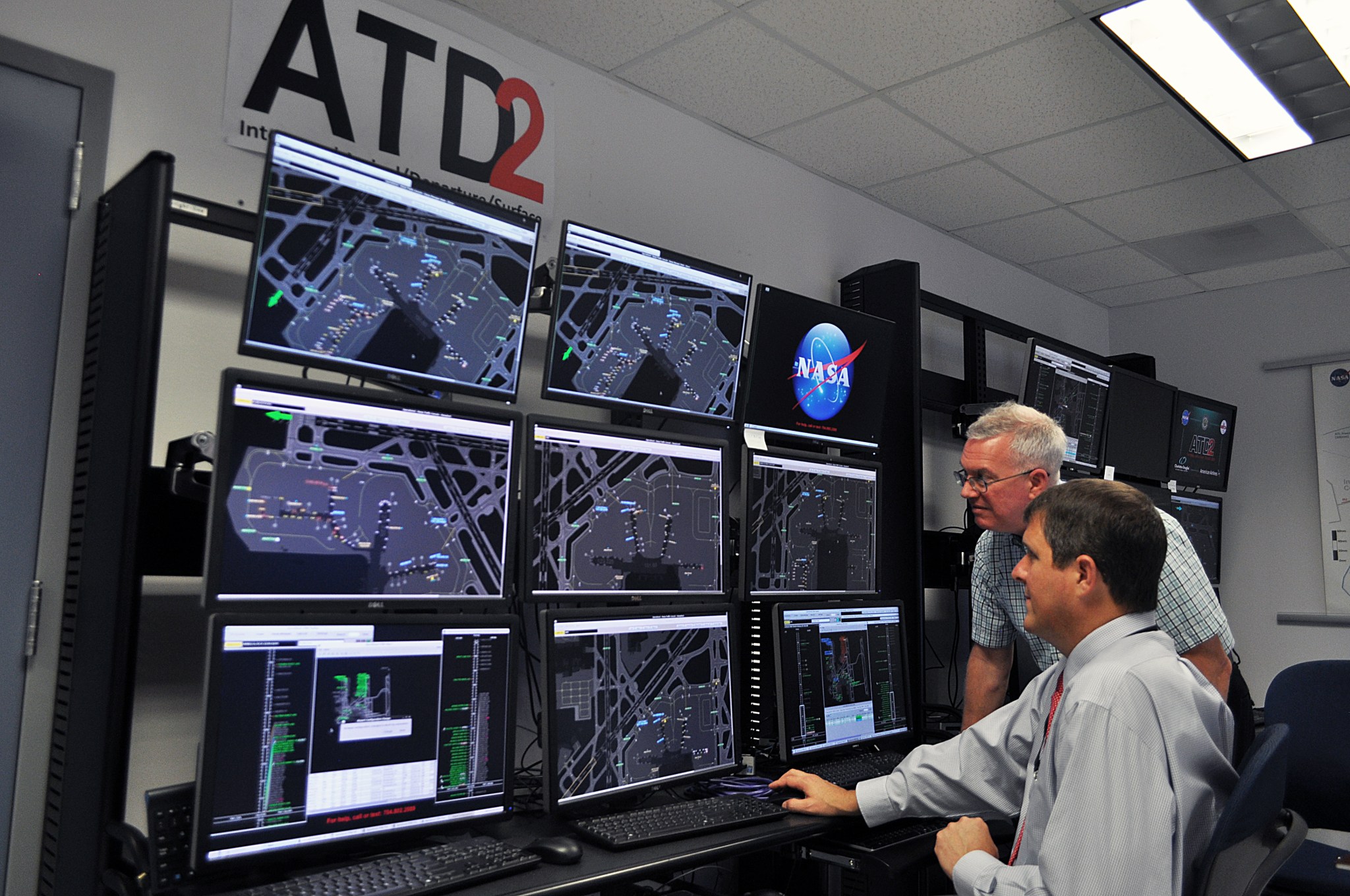
Milestones:
ATD-2 included two separate field demonstrations of the Integrated Arrival Departure Surface, or IADS, system:
- A single-airport demonstration at Charlotte Douglas International Airport in North Carolina (Sep. 2017-Sep. 2020)
NASA developed core components of the IADS system and used them to validate concepts developed by the FAA and industry. In addition to the technology that was transferred by NASA, lessons were learned from the demonstration that reduced risk for the FAA’s implementation of the ATD-2 capabilities and established the business case for required industry investments. Although NASA’s single-airport research ended in September 2020, the FAA continues to support ATD-2 operational use at Charlotte to facilitate transition to TFDM.
- A multi-airport demonstration at Dallas/Ft. Worth International and nearby Dallas Love Field airports in Texas (April-Sep. 2021)
The team extended the single-airport tools to improve the efficiency of surface operations at neighboring airports, where departing flights compete for limited airspace resources. Using IADS’ surface traffic predictions, NASA’s terminal scheduler tool assessed demand to use the airspace versus its capacity and provided recommendations for efficient rerouting of flights.
Partners:
The Airspace Technology Demonstration 2 was run out of the Aviation Systems Division at NASA’s Ames Research Center in California’s Silicon Valley, in collaboration with the Federal Aviation Administration. The project was managed by NASA’s Airspace Operations and Safety Program. American Airlines, Southwest Airlines, the National Air Traffic Controllers Association, Charlotte Douglas International Airport, Dallas/Ft. Worth International Airport and Dallas Love Field Airport all partnered with NASA in the field demonstrations.
NASA Stimulates a Smooth Ride to Stabilize Air Taxis
by Rachel Hoover
When air taxis begin shuttling us around, the rides they offer will need to be safe and smooth. These small electric aircraft will be nimble enough to operate in cities, but sudden gusts of wind could cause a turbulent flight – for example, by setting off an up-down movement of the wings combined with rocking side to side. To nip that unstable motion in the bud, NASA is researching a system that could actively suppress it, with the help of high-performance computer simulations.
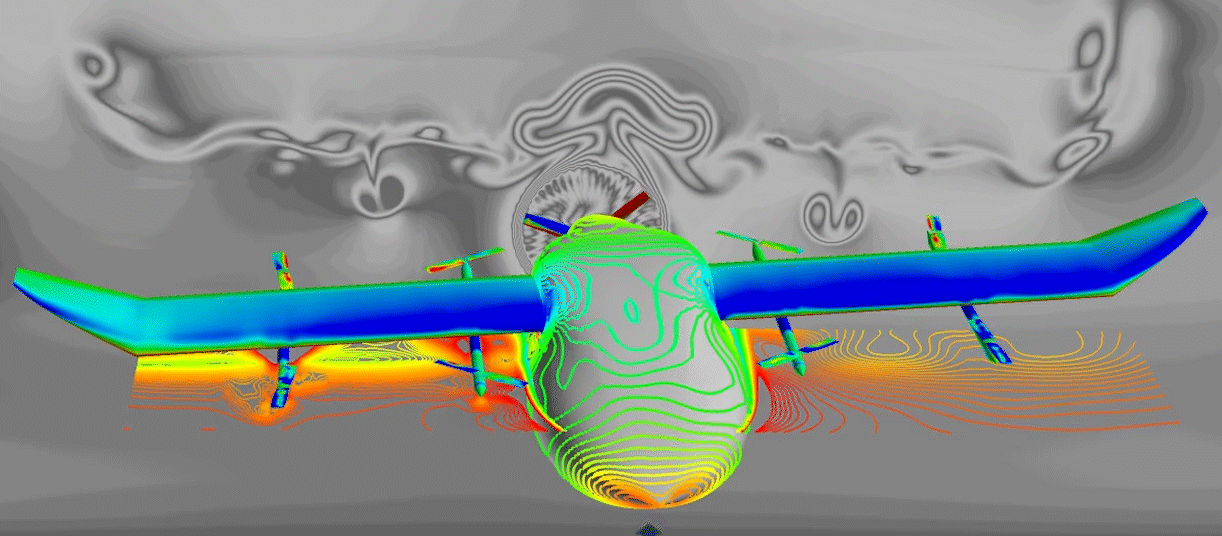
This video shows a computer simulation of the system at work. A generic concept design for an air taxi has begun to tip and rock following an unexpected wind gust. As the wing to the viewer’s right begins to move down, the outer propellers on that side spin extra fast to lift the wing back up – visualized as an airflow pattern in bright orange, indicating their high rotation speed. The farther down the wing is tipped, the faster the propellers rotate. The process alternates between the wings until the unstable motion has stopped.
Complex computer simulations help researchers assess their potential systems and make them better. The computations needed to evaluate the conceptual system for active air taxi stabilization shown here required the capabilities of the Pleiades supercomputer at the NASA Advanced Supercomputing facility at NASA’s Ames Research Center in California’s Silicon Valley. The successful simulation demonstrates how high-powered computers can help assess air vehicles for NASA’s work in Advanced Air Mobility and help improve safety in future vehicles.
NASA is showcasing 39 of the agency’s science, engineering, and technology achievements, including this simulation, at SC21, the international supercomputing conference, Nov. 14-19, 2021, in St. Louis. For more technical information, visit: https://www.nas.nasa.gov/sc21
Supercomputing Reveals “Fossil Record” of Galaxy Collisions and Mergers
by Rachel Hoover
How do galaxies evolve into the starry spirals famously seen by NASA’s Hubble Space Telescope and others? Researchers sought answers about the faint stars and gases surrounding galaxies like our own. Using the Pleiades supercomputer at the NASA Advanced Supercomputing facility at the agency’s Ames Research Center in California’s Silicon Valley and data from Hubble, they simulated a Milky Way-like galaxy in the early stages of a collision with another smaller galaxy.
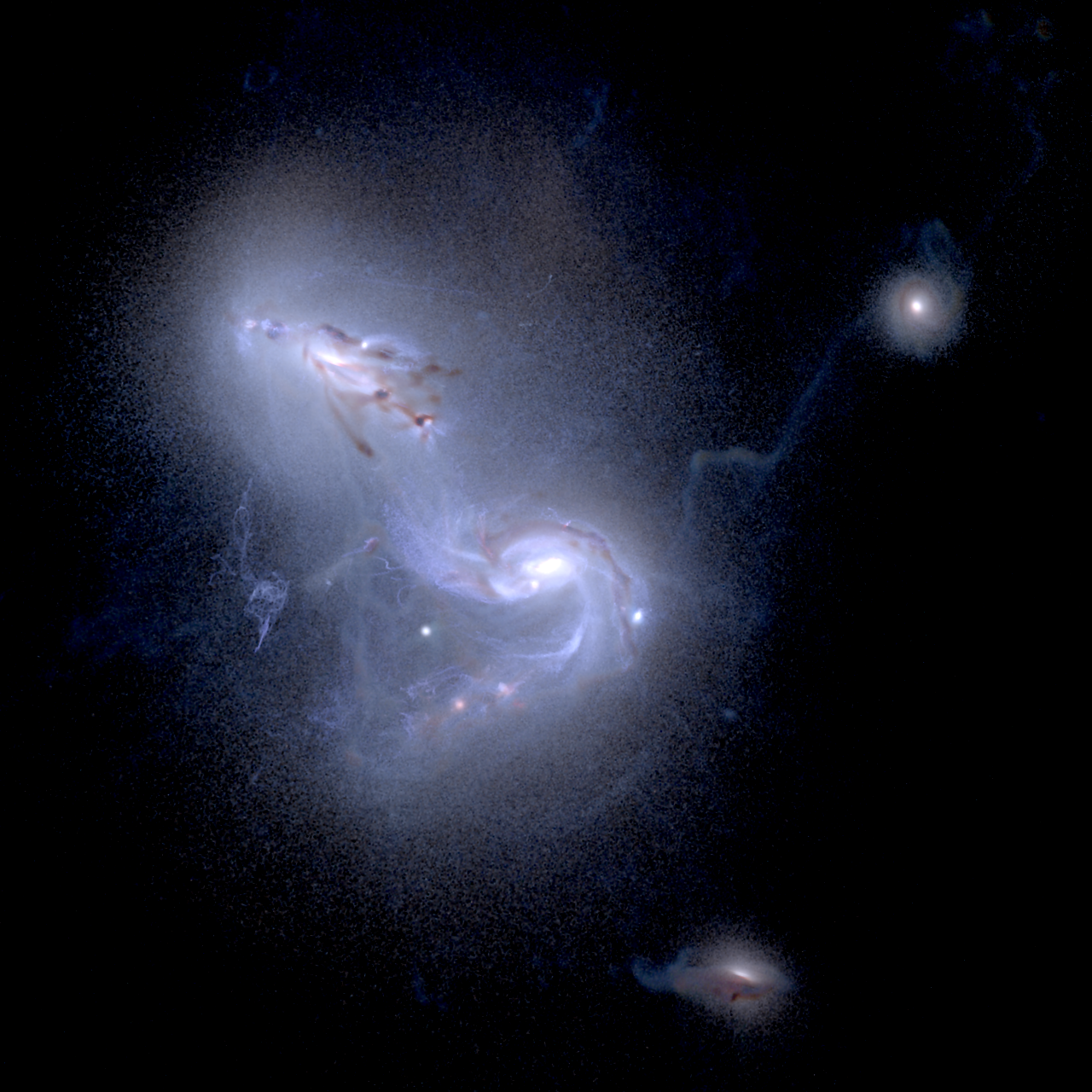
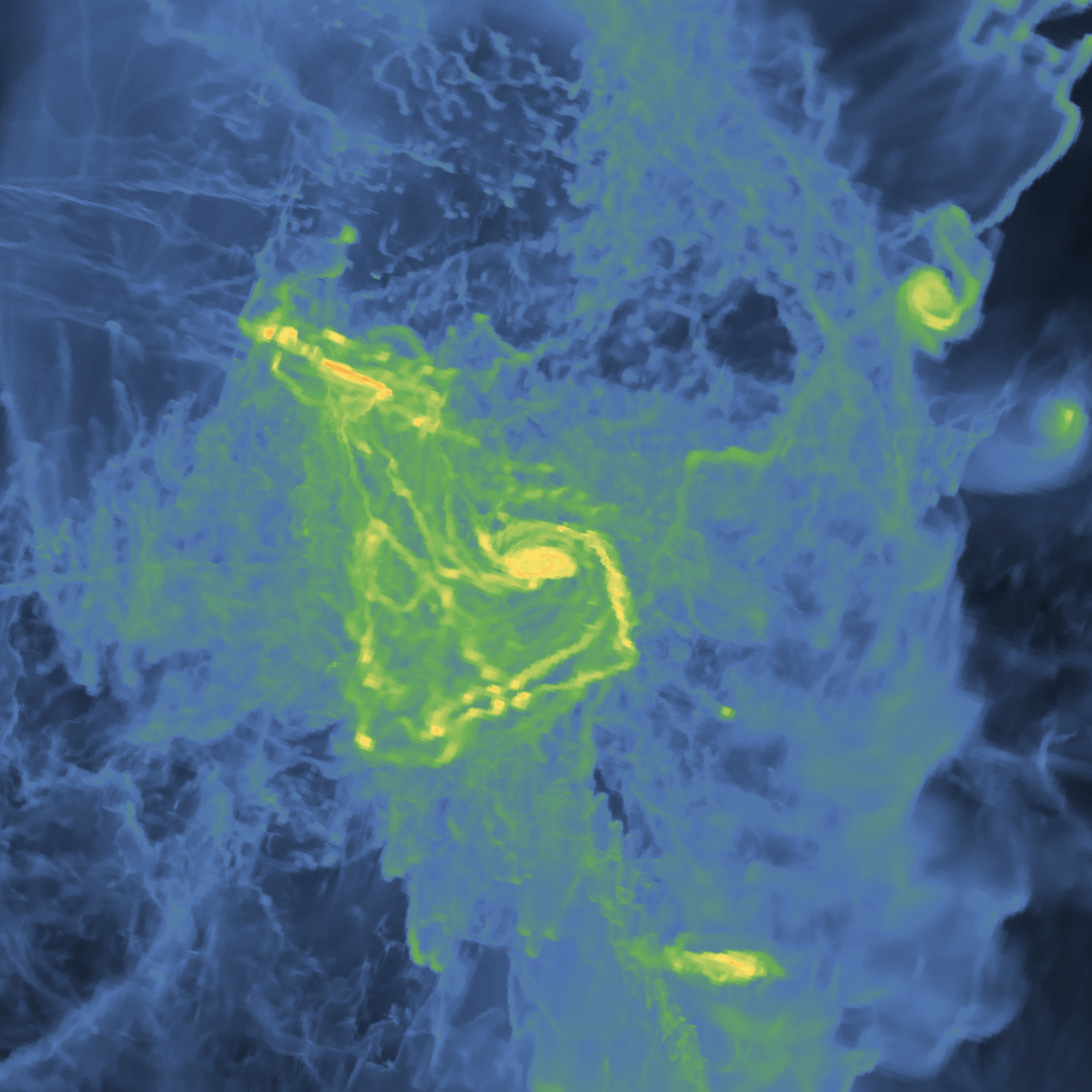
This image sequence shows two simulated galaxies in the early stages of a collision that will ultimately throw many stars from both galaxies into wide orbits, creating a faint stellar halo around the larger galaxy. The top image features stars and interstellar dust visible to the human eye; gases are largely invisible. The bottom image features interstellar low-density gases in blue to high-density gases in orange.
The visualization revealed a detailed “fossil record” of information about the simulated galaxy’s history. Basically, when we gaze at the halo of stars and luminous clouds of interstellar dust surrounding a galaxy’s milky multitude, we’re seeing remnants of smaller, neighboring galaxies that were shredded by galactic mergers.
These cosmic crashes throw many faint stars into enormous wide orbits, ultimately landing them out in the galaxies’ far-flung fringes. Researchers also found the outlier stars sometimes form streams that wrap around a larger galaxy and last billions of years.
The data from these simulations is now helping scientists make predictions about how to detect and trace the histories of stellar streams to figure out what they can tell us about the galaxies that made them, including the streams around our own Milky Way. For example, NASA’s upcoming James Webb and Nancy Grace Roman space telescopes are expected to give us a detailed look at the stellar halos of dozens of nearby galaxies for the first time.
NASA is showcasing 39 of the agency’s science, engineering, and technology achievements, including these simulations, at SC21, the international supercomputing conference, Nov. 14-19, 2021, in St. Louis. For more technical information, visit: https://www.nas.nasa.gov/sc21
Applications for the 2022 Virtual NASA Space Life Sciences Training Program (SLSTP) are Now Open
The 2021 SLSTP Virtual program concluded on Friday, Aug. 13. Eleven research associates (RAs), two staffers, and 10 Ames mentors participated in the program funded by NASA Ames’ Space Biology Program. The RAs worked remotely from four different time zones and spent 80 percent of their time on projects with their individual Ames mentors and 20 percent of their time on a group project and professional development activities.
Professional development and networking activities are important components of the program and included:
- Professional Development: coaching on public speaking, preparing an elevator pitch, proposal writing tips, and a resume building session.
- Networking: receptions with GeneLab and Ames Space Biology scientists, small interactive meetings with Space Biology and NASA directors: Drs. Kevin Sato, Michael Hesse, and Sharmila Bhattacharya, meetings with SLSTP program alumni, and seminars from 2021 mentors. SLSTP RAs also had virtual meetings with notable scientists including Drs. Chris McKay, Jean Sibonga, Laurie Barge, Michael Pecaut, Astronaut Jim Pawelczyk, and Nobel laureate John Mather.
- Virtual Tours: The intensive schedule also included introductions to the RAs to Ames history (lecture by Ames Historian, James Anderson) and Ames facilities via virtual tours of the Ames Human Centrifuge, the Virtual Motion Simulator, Virtual SimLabs, and “Recreating the ISS for Virtual Reality”.
For their group project component, 2021 SLSTP RAs developed a white paper for the Decadal Survey on Biological and Physical Sciences Research in Space 2023-2032 entitled, “Immunological Consequences of the Spaceflight Environment on Macrophage Function.” The document also is being developed as a mini review for peer-reviewed publication. The major component of the SLSTP internship are individual projects with Ames mentors. During the application process, applicants choose and rank specific projects/mentors, and the final choice of the highest ranked interns is done by the individual mentors. Prior to the Covid-19 pandemic, most of the projects were laboratory-based. The list of virtual projects from Summer 2021 is shown below. To culminate the program, SLSTP held two sessions of formal oral presentations by the RAs of their individual and group projects. The RAs also have the opportunity to present their work either in person at the annual conference of the American Society for Gravitational and Space Biology (ASGSR) or virtually at the student e-poster competition at the annual conference of the American Association for the Advancement of Science (AAAS).
On the final day of the program a ceremony was held to congratulate the students on their participation in the program. Students received certificates acknowledging their individual contributions and program participation during the 2021 program.
Applications are now open for the 2022 session of the popular NASA Ames’ Space Life Sciences Training Program (SLSTP). Upper-division STEAM students from around the country will compete for a spot in the intensive 10-week summer program. The immersive SLSTP program will again be run virtually for the third year from June 6 – Aug. 12, 2022. SLSTP Summer 2022 will include Ames Space Biology-related projects ranging from synthetic biology to bioinformatics to machine learning and spaceflight experiments. The primary goal of the program is to train the next generation of scientists and engineers, enabling NASA to meet future research and development challenges in the space life sciences. The application website is here.





